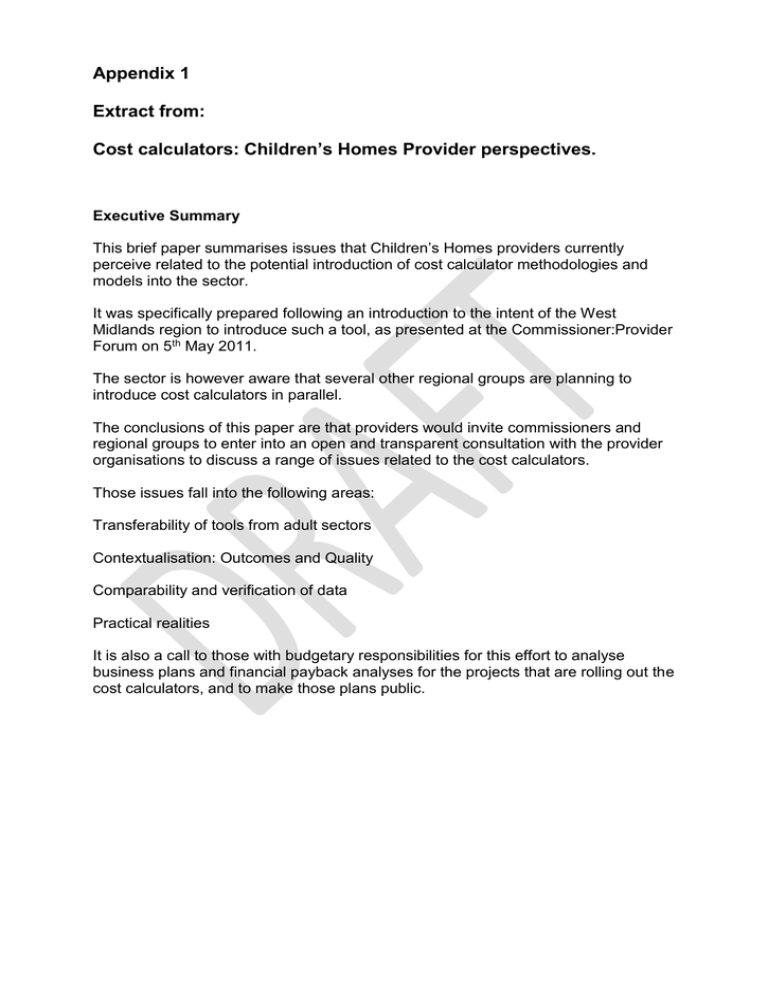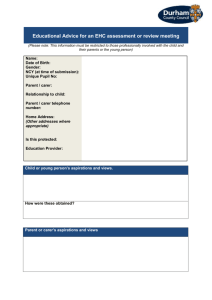Appendix 1 and 2 to Children's Homes commissioning
advertisement

Appendix 1 Extract from: Cost calculators: Children’s Homes Provider perspectives. Executive Summary This brief paper summarises issues that Children’s Homes providers currently perceive related to the potential introduction of cost calculator methodologies and models into the sector. It was specifically prepared following an introduction to the intent of the West Midlands region to introduce such a tool, as presented at the Commissioner:Provider Forum on 5th May 2011. The sector is however aware that several other regional groups are planning to introduce cost calculators in parallel. The conclusions of this paper are that providers would invite commissioners and regional groups to enter into an open and transparent consultation with the provider organisations to discuss a range of issues related to the cost calculators. Those issues fall into the following areas: Transferability of tools from adult sectors Contextualisation: Outcomes and Quality Comparability and verification of data Practical realities It is also a call to those with budgetary responsibilities for this effort to analyse business plans and financial payback analyses for the projects that are rolling out the cost calculators, and to make those plans public. Credentials. The issues discussed below are largely drawn from my own personal perspective. However, through Revolution Consulting I have started to gather input from a number of providers in the sector to add further perspective. My own views come from: I am a Fellow of the Institute of Chartered Accountants in England and Wales (with almost 25 years commercial experience). I have over 10 years’ direct experience of the Children’s Home sector having been Managing Director of the largest service provider, and chairman of the trade association until 2005 and having established a completely new service from scratch from 2007 until it’s subsequent sale in 2012. Through Revolution Consulting I have worked on projects with many Local Authorities, regional groups and providers gaining intimate insight into detailed financial dynamics on both sides. In other consultancy projects I have evaluated the benefits from the application of cost calculator tools in the Adult Learning Difficulties sector. The Commissioning Support Programme published a paper that they commissioned from Revolution in 2009 looking into the relative financial strengths of services for children and the implications for commissioners. This is available on the CSP website, or directly from Revolution Consulting (contact@revolution-consulting.org) Background The Commissioning Support Programme report referred to above (and updated since) highlights dramatically different financial performance in the Children’s Home sector compared to the other sectors (Residential Special Schools and Fostering). I have long advocated that commissioners at all levels get smarter in their understanding of what this means. In particular, it is impossible not to conclude that it is in fostering and residential schools where the larger profit margins are reported and where, logically, commissioners might better direct their activities. I have recently commissioned a study of the sector from the point of view of looking at how many different databases/preferred provider lists/regional commissioning systems are in existence and which providers potentially have to engage with in order to do business in England and Wales. The shocking conclusion was that there are at least 8 regional databases/systems, 19 authorities use their own systems and don’t use regional tools, and there are another 70 corporate procurement portals that authorities may use. Several providers do not believe that the investment required to gain entry to, and maintain position on, so many databases and portals is not justified in terms of the actual utilisation by individual authorities. The potential for costs calculators to be implemented in a similarly piecemeal fashion across the country is a recipe for gross inefficiency. As I write this version of this paper the Bank of England has just announced that it expects inflation to reach 5% in 2011. Most providers have been squeezed by inflation, VAT increases, Employer National Insurance increases, and yet been faced by demands for reduced fees. Community Care also reports that Children’s Homes providers have noted a dramatic downturn in referrals since the Comprehensive Spending Review. It is therefore not difficult to envisage that some Children’s Home providers will again be experiencing sustainability issues. The burden of a big modelling exercise that has at least some intention to reduce their prices/costs risks closure of homes, loss of capacity, reduced competition and capability in the sector. Where the tool comes from The cost calculator tools being discussed have their roots in application to the Adults residential sector, and to Adult Learning Difficulties settings in particular. Clearly some Directors in local authorities perceive that the tool has been responsible for real cost savings in that sector, and therefore that it may have application over in the Children’s residential sectors. As Revolution Consulting I have carried out evaluations of such Adult sector applications. The conclusions based on those evaluations are less persuasive. In most cases, an objective assessment of the financial evidence to any reasonable standard finds that the evidence of savings does not stand up well to close scrutiny. Many projects did not set out to measure the financial impact objectively at the outset and claims of savings are sometimes questionable. In addition, the link between the cause of a claimed saving and the use of a costing tool is often unproven. It was my personal impression that the simple act of addressing the market in a parallel fashion for each referral rather than a serial approach was as likely to have generated benefits without the use of the costing tool. From Adults to Children When considering the potential to apply the adult based tools to Children’s services, further factors come to mind: A. In simple terms, adult residential settings do have some stability about them in terms of a homogeneity of needs, homogeneity of care packages and resources, and stability of demand and occupancy that potentially allow the cost calculator to have some utility. My every instinct is that application to children’s services is much more difficult, complex and volatile. B. Children and young adults in the care system display a wide range or needs and challenges, often multiple and complex challenges in each placement. Costing models risk ignoring the skill and judgement of professionals and providers in matching young people to placements, and in providers who risk assess on an almost daily basis both the cohort at a site, and the strengths of the staff group, and then organise staffing to best manage the needs on each day based on the activities of the cohort. In other words, done properly, you cannot hope to model staffing levels anywhere near accurately because of this variability. Adults homes tend to have more rigid and predictable staffing rotas. C. There is not stable demand, supply or occupancy rates in the majority of Children’s Homes. Financial outcomes, costs, fees etc. are far more sensitive to occupancy than to anything else. Homes are on average much smaller than in adults’ services, a fact that magnifies the impact. The case in point to illustrate this is a two bed unit. If the provider costs the placements when full, and then the next day a child leaves, then the costs DOUBLE per bed overnight. With that level of impact then facts such as whether the cost of care worker is +/- 5% becomes irrelevant. Quality and Outcomes The Cost Calculators do not measure outcomes or quality. This alone is their greatest failing. The tools risk putting outstanding rated homes that achieve placement stability, engagement with education, and therapeutic input, alongside failing homes that simply contain young people. Without a tool to measure outcomes consistently across providers the cost information has no context and could be rendered worthless. Several independent reports (e.g. Demos – In Loco Parentis) in the last year have strongly advocated that whole life costs are what is important in the assessment of value of services for children. Point in time snapshots of costs fail to achieve this. Different accounting approaches For any kind of credibility the tools have to be applied to all provision, including local authority provision, charity/voluntary sector provision and private sector provision. The accounting rules and statutes governing the information required for reporting in each of those sectors are different for each sector. It was accepted by the presenters at the West Midlands event that the model therefore is unable to make fair comparisons on a similar basis. My accountancy experience is that organisations in these sectors have very different overhead infrastructures, and that two organisations in the same sector may well utilise different overhead allocation methodologies. Hence comparability is further undermined even within each sub-sector. Checking the figures Various statutes require that financial information reported publically shall be subject to independent audit. Small organisations (including many providers) are exempt from audit requirements. The cost calculator tools potentially provide a mountain of detailed costing data. Providers are concerned that the following issues have not yet been addressed: 1. The depth and complexity of data goes beyond what could be said to be reasonably required by contract terms. The cost of producing the data may therefore need to be passed on to the purchaser as a separate and additional charge for the information. 2. There would appear to be no mechanism to audit or verify that all providers have applied the same accounting approaches or indeed whether the figures provided are accurate. 3. Local authorities will need to invest in resources to handle the data provided. This is both a capacity issue and a capability issue. The volume of data is potentially vast, and will require new skills to interpret. Providers would be concerned to know that the people receiving the information were qualified and experienced in understanding financial accounting in all forms and sectors. 4. The data provided is potentially commercially sensitive and therefore confidential to each provider. Commissioners using cost calculators will need to address the issues related to this. Practical realities The simplistic assumption about return on investment described at the West Midlands event is fatally flawed. It takes no account of intangibles such as knowhow, or where in the project life-cycle a home or organisation sits. Staff are rarely variable costs. Levels of sickness, staff churn, overtime rates, staff rotas, payments for bank holidays, holiday cover, pension scheme membership rates and contribution levels, employer burden (e.g. NI rates) do not stay fixed and sometimes vary daily depending on events shift by shift. Unpredictable costs can be significant – repairs, overtime, recruitment, training, staff churn, insurance rates, fuel prices, VAT rates, interest rates. The model doesn’t accommodate start-up/loss-leader pricing, or volume discounts, or early payment discounts, or preferred provider discounts, or block contract pricing. In short it is just not reflective of a dynamic pricing marketplace. Recommendation The sector needs to ask to see that a robust financial payback assessment of this project has been made. This should include a real costing of the time and resources required to implement several calculators across multiple regions. Benefits need to be carefully tested and valued, taking full regard of the points and issues raised above. My every instinct is that in these stressed economic times the sector could invest these resources more wisely in finding efficiencies in other ways (and other sectors). I believe the efforts and funding going into cost calculators would be more gainfully employed in looking for ways to address variable demand and occupancy patterns that providers experience. There is ample clear evidence that local authorities and providers create mutual efficiency through the smart use of techniques that lower volatility of demand and secure greater predictability on the supply side. It is difficult to comprehend how an onerous costing tool has any impact on the fundamental dynamics of supply and demand, or what it does to improved outcomes for the most vulnerable and challenging cohort in our society. I believe the sector is always willing to see other perspectives, and I am sure that the sector would benefit from an open and detailed consultation nationally on this issue. That is what this paper invites. Appendix 2 Service cost headings 1. An operational children’s home 1.1 Staffing. Core rota residential care staff salaries, Employer National Insurance, bonuses, sleep-in allowances, waking night allowances, Employer pension contributions, other benefits costs (e.g. sick pay, holiday pay, maternity and paternity pay, private health insurance) Supplementary sessional staff costs to cover core rota vacancies, holidays, sickness and training absences. Includes all of the above cost elements, to the extent they apply to sessional staff. And/or – third party agency costs for agency staff, including the agency fee. Registered Manager (and Deputy Manager) – costs as above plus expenses (e.g. travel costs, GSCC registration). Ofsted Registration costs. Other support staff costs. E.g. ancillary staff – cleaners, gardeners, cooks, staff mentors. 1.2 Staff recruitment. Costs of HR effort to identify recruitment needs early. Cost of advertising, other recruitment schemes, “recommend a friend incentives”… Cost of processing replies and enquiries. Costs of interviews and screening. Costs of CRBs and other vetting both at initial recruitment point and on an ongoing basis. Internal resources to manage this (people, database, prompting systems) and the external CRB and postage costs. Cost of having staff on induction but not yet on shift. 1.3 Staff training. Costs of in house training – induction, safeguarding, etc Costs of external training where bought in. Both statutory requirements (NVQ and CWDC) and organizational development requirements. Costs of operating supervision and appraisal systems, capturing information. Costs of running talent identification and succession planning systems. 1.4 Staff leaving. Costs of resources to manage complaints, insurance claims and employment law related claims. Costs of resources for exit interview processes. 1.5 Staff rostering. Costs of people and systems to roster staff across multi-site operations, to manage daily issues of sickness and other absence, to call on sessional or agency staff. IT systems to support this activity. 1.6 Professional support to the home Professional social work managers and administrators who support the care planning, reviews, placement processes, across multiple homes. Also perform supervision of registered managers. Regional or operational managers and directors overseeing larger groups of operations, reporting to corporate centre, ensuring good QA, responsible for outcomes and economic performance of their homes. Costs may include company car and fuel costs and expenses. 1.7 Internal QA and Reg 33 costs Internal or external people and related costs of QA. 1.8 Property Costs. Capital acquisition costs Stamp duty, legal fees, search fees Mortgage or borrowing costs Or Rental costs, plus finders fees, lease negotiation costs and legal fees Repairs and renewals costs Maintenance team costs – including associated NI, pension, vans, tools, equipment. Heat, light, electricity, postage, telephone. Equipping the house – furniture, crockery, cutlery, appliances,… Equipping the office at the home – desk, IT, fax, filing, safe,… 1.9 Variable house costs. Related to number of children/staff in residence Food Consumables Personal care Cleaning materials Activities Pocket Monies 1.10 Transport Capital cost of house vehicles Or rental thereof Mileage paid where personal car used Maintenance and running costs Fuel costs Repair costs Fleet management costs 1.11 Advocacy 2. Fostering 2.1 Carer payments Allowances Payments Fees Cost of vacancies if on retainers Travel expenses 2.2 Carer recruitment and assessment Advertising costs Internal and external Form F costs Process management costs 2.3 Carer training Pre approval costs Post approval training costs - ongoing 2.4 Carer Support Cost of venues Cost of cover Cost of facilitating support meetings Cost of link workers, offices, phones, vehicles or mileage Cost of out-of-hours support 2.5 Management of service Cost of social work qualified management Supervising social workers Office, IT etc.. Internal QA External registration Cost of respite provision Education liaison 2.6 Equipment/Home alterations 2.7 Advocacy 2.8 Panel costs 2.9. Staff training 2.10 Property and Offices 2.11 Cars/vehicles and expenses 3. HR support Cost of trained HR professionals and administrators to support recruitment, HR policy development, remuneration development, staff and carer vetting, contracts, insurances, staff and carer leaving systems, staff and carer training recording, staff and carer development processes. Offices, furniture, IT equipment, facilities for the HR team. 4. Payroll support Cost of trained payroll and incentives professionals and administrators to ensure all staff and carers are properly paid, to deal with queries, budgets, changing employment and tax legislation. 5. Insurances Property and contents Public Liability Employers liability Personal accident Travel Professional Indemnity Vehicle insurance – house vehicle, company cars, staff using own vehicles 6. IT People, hardware, software, systems to run the organisation Offices etc to house the IT support. Security, Disaster recovery resources. 7. Corporate management and overheads Directors and managers and associated costs. Strategic development and liaison with owners and financiers. Corporate offices and admin support throughout. Stationery, post, copying, office consumables, rent, rates, heat, light, furniture, IT etc… 8. Finance/Legal.and return on investment Financial reporting team Invoicing, credit control, paying suppliers Legal liaison Contracts management – leases, car contract hire, photocopiers, phone company deals,…. Purchasing/procuring resources. Bank charges Interest on borrowings Ofsted registration and other regulatory costs. (External QA, External H&S accreditation, Financial audit) 9. Referrals , marketing, tendering Interface to customer/placement offices Managing enquiries and referrals Managing contracts Monitoring contract compliance 10 .Marketing, advertising services to potential customers. 11. Education related In house tutoring Education support resources School liaison 12. Professional services Therapeutic services bought in Psychologist support, Psychiatrist support Assessment costs 13. Education Provision of registered education provision involves similar structures of: Staff costs Management costs Property costs Education resources (books, materials, activities) Transport costs Insurance costs And reliance on the HR, Finance, Payroll, Legal, IT and corporate services. 14. Return on investment





